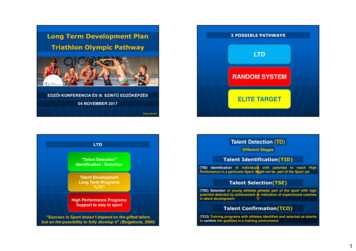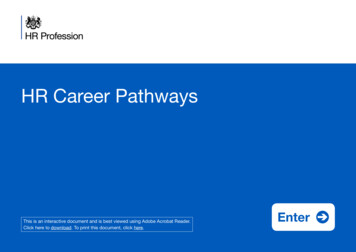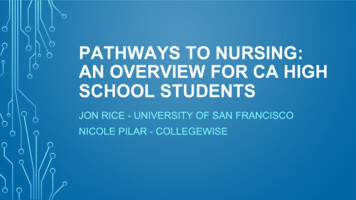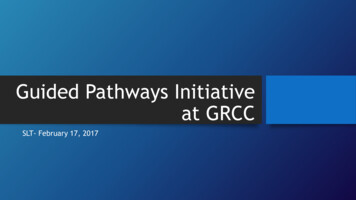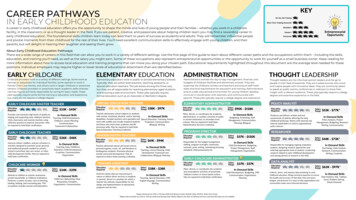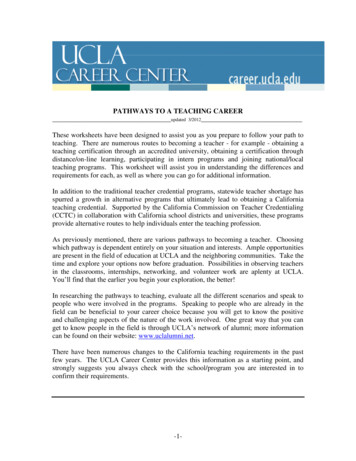
Transcription
PATHWAYS TO A TEACHING CAREERupdated 3/2012These worksheets have been designed to assist you as you prepare to follow your path toteaching. There are numerous routes to becoming a teacher - for example - obtaining ateaching certification through an accredited university, obtaining a certification throughdistance/on-line learning, participating in intern programs and joining national/localteaching programs. This worksheet will assist you in understanding the differences andrequirements for each, as well as where you can go for additional information.In addition to the traditional teacher credential programs, statewide teacher shortage hasspurred a growth in alternative programs that ultimately lead to obtaining a Californiateaching credential. Supported by the California Commission on Teacher Credentialing(CCTC) in collaboration with California school districts and universities, these programsprovide alternative routes to help individuals enter the teaching profession.As previously mentioned, there are various pathways to becoming a teacher. Choosingwhich pathway is dependent entirely on your situation and interests. Ample opportunitiesare present in the field of education at UCLA and the neighboring communities. Take thetime and explore your options now before graduation. Possibilities in observing teachersin the classrooms, internships, networking, and volunteer work are aplenty at UCLA.You’ll find that the earlier you begin your exploration, the better!In researching the pathways to teaching, evaluate all the different scenarios and speak topeople who were involved in the programs. Speaking to people who are already in thefield can be beneficial to your career choice because you will get to know the positiveand challenging aspects of the nature of the work involved. One great way that you canget to know people in the field is through UCLA’s network of alumni; more informationcan be found on their website: www.uclalumni.net.There have been numerous changes to the California teaching requirements in the pastfew years. The UCLA Career Center provides this information as a starting point, andstrongly suggests you always check with the school/program you are interested in toconfirm their requirements.-1-
CREDENTIAL REQUIREMENTSIn most cases, in order to teach in a public K-12 school in California, you will need avalid teaching credential. There is a sequence of requirements (also known as the twotiers) to receive the authorization to become a fully certified teacher: The PreliminaryCredential and the Professional Clear Credential.Receiving the Preliminary Credential is the first tier and it allows you to teach for amaximum of five years. During that time, additional professional development isrequired to receive the Professional Clear Credential. The holder of the PreliminaryCredential will not be able to continue teaching in California’s public schools if thoserequirements are not met. This worksheet will give you the introductory information toreceiving the Preliminary Credential.TYPES OF PRELIMINARY CREDENTIALSThere are three types of Preliminary Credentials: Multiple Subject, Single Subject, andSpecial Education.Multiple Subject Credentials:The Multiple Subject Teaching Credential authorizes the holder to teach in a selfcontained classroom such as the classrooms in most elementary schools. A selfcontained classroom is a one where a teacher teaches all subjects to the same students allday. However, a teacher authorized for multiple subject instruction may be assigned toteach in any self-contained classroom whether it be in preschool, K-12, or in adultclasses.Admission criteria vary by school, but general requirements to gain admission to schoolsoffering Multiple Subject Credentials include the following: Complete a bachelor's degree (any major). Pass the California Basic Educational Skills Test (CBEST). Verify knowledge of the subject by passing the California Subject Examinationfor Teachers (CSET) U.S. Constitution requirement (pass an examination or take an approveduniversity course). Take the Graduate Record Examination (GRE): Some schools, but not all, willrequire this examination. Complete a certain number of hours of student contact (student teaching, tutoring,observing). Write a Personal Statement. Have approx. 3 letters of recommendation. Complete necessary fingerprinting/administrative requirements.-2-
Single Subject Credentials:This certification authorizes the holder to teach a single subject in departmentalizedclasses such as those in most middle schools and high schools. Teaching with a SingleSubject can also be applied to preschool, kindergarten, grades 1-5, and adult classes;however, you can only teach the specified subject that the credential authorizes.Admission criteria vary by school, but general requirements to gain admission to schoolsoffering Single Subject Credentials include the following: Complete a bachelor's degree (any major).Demonstrate subject-matter proficiency via one of the two methods:o Passage of the California Subject Examination for Teachers (CSET)o Complete a Commission-approved subject-matter waiver program (moreinformation on this is included later in the packet)Pass the California Basic Educational Skills Test (CBEST).U.S. Constitution requirement (either pass an examination or take an approveduniversity course).Take the Graduate Record Examination (GRE): Some schools, but not all, willrequire this examination.Complete a certain number of hours of student contact (student teaching, tutoring,observing).Write a Personal Statement.Have approx. 3 letters of recommendation.Complete necessary fingerprinting/administrative requirements.Special Education Credentials:This certification authorizes a person to teach children with special needs. Specialeducation teacher preparation program, including student teaching must be completed inthe area of specialization. The person holding this credential may work with elementary,junior high, or high school students.Admission criteria differ by school, but general requirements to obtain your SpecialEducation Credential include the following: Complete a bachelor's degree (any major).Pass the California Basic Educational Skills Test (CBEST).Verify knowledge of the subject by passing the California Subject Examinationfor Teachers (CSET)U.S. Constitution requirement (pass an examination or take an approveduniversity course).Take the Graduate Record Examination (GRE): Some schools, but not all, willrequire this examination.Complete a certain number of hours of student contact (student teaching, tutoring,observing).-3-
Write a Personal Statement.Have approx. 3 letters of recommendation.Complete necessary fingerprinting/administrative requirements.Selecting the appropriate credentialMost students are going to pursue one credential, either the single subject or the multiplesubject. Keep in the mind that each permit will allow you to teach in a certain setting, butthe credential is not typically transferable to different grade levels. Consider your goalsand the age of the student you want to instruct as you decide which credential to pursue.What grade level do you want to teach?Elementary school - Kindergarten – 5th or 6th gradeCredential NeededMultiple SubjectMiddle School - 6th - 8th grade(Multiple Subject specific)*Middle School - 6th - 8th grade(Single Subject specific)**Secondary School - 9th - 12th gradeMultiple SubjectSingle SubjectSingle Subject* Multiple Subject Specific - Some middle schools hired Multiple Subject Teachers toteach self-contained class periods. For instance, block sessions instruct more thanone subject. These classes are often humanities classes such as Social Science,Language Arts and Literature Classes** Subject Specific - If you wish you to teach specific courses in middle school (forexample, math or science only) you will want a single subject credential.OBTAINING THE PRELIMINARY CREDENTIALIt is important to note that for the most part, all teacher preparation programs must bedone post the baccalaureate degree, and that there is no education major in the state ofCalifornia.Types of Credential Programs: You must consider a variety of factors when choosing ateacher preparation program. For instance, location, program options, tuition, and otherfactors will all play a part in your decision. The first two pathways are the preferredroutes to completing your credentials as mandated by the State of California. If you gothrough these traditional routes, then the beginning teacher salary will be higher thanthat of the other alternative pathways presented below. Again, it is strongly encouragedto contact the respective school districts and universities that offer these programs toinquire about program specifics, i.e. requirements, timelines, etc.1. Graduate School Credential Programs: Those programs allow you to earn aMaster’s degree while simultaneously earning the Preliminary Credential. These-4-
programs can be 1 year to 2.5 years in duration, and often contain a studentteaching component. The type of Master's degrees may vary according to theprogram. Often they are Master's Degree in Education (M.Ed.), Master's of Arts(M.A.) in Education or a Master's in the Art of Teaching (MAT). Many schoolsrequire that you take the Graduate Record Examination (GRE) prior to entrance.a. While the cost of tuition is the responsibility of the student, certain loanforgiveness programs such as APLE (Assumption Program of Loans forEducation) benefit the student. More information on this specific programcan be found at www.csac.ca.gov. It is advisable to discuss fundingoptions with a counselor in the program that you desire to pursue.2. Credential Only Teacher Preparation programs: These programs are typically 918 months in duration. The majority of these programs can be found in stateprograms such as those of the California State University system and privateprograms like those of Pepperdine University. Some UC schools (includingUCLA) offer a credential only program as well. They will prepare you for yourPreliminary Credential and will usually have a student-teaching component.a. The CCTC has a complete list of the schools that offer commissionaccredited teacher preparation programs. The updated list can be found html click on the linkunder the Resources section that reads “Commission-ApprovedProfessional Preparation Programs.”For more specific programinformation and requirements, you should contact the individual schools.Other Permits that allow immediate entry to teaching:The following permits can only be obtained through the hiring employer (school district),and only after proof of inability of finding an eligible teacher for the position has beensupplied to the CCTC. You would not be able to apply directly for these permits throughthe CCTC, but you may be able to contact the school districts individually to ask aboutpossible openings. Permits are available in each of these areas: Multiple-Subject,Single-Subject, and Education Specialist Instruction. The prerequisites remain the sameas other certificates: B.A./B.S. degree, CBEST exam passage, and Subject-MatterCompetency/CSET passage. You will not be able to receive any of those permits if youhave already been issued five Emergency Permits.1. Provisional Intern Permit (PIP): This permit can be provided for a maximum oftwo years, but it must be renewed each year. It is provided as a solution toanticipated staffing need.2. Short-Term Staff Permit (STSP): This permit was created and implemented intoeffect in order to permanently phase out the substitute teaching (EmergencyPermits). It is short term and it is valid for one year. It is provided as means to anacute staffing need, for example, if a teacher is not able to complete a school year,-5-
then the district may hire an individual with an STSP. However, this is a measurereserved as a last resort to districts unable to find a suitable substitute.Teaching Immediately Upon GraduationFor various reasons, some students opt to start teaching immediately upon graduatingwith a 4-year degree. Several possibilities allow you to do this!! It is important to weighthe pro’s and con’s to teaching immediately. It is recommended that you talk with acareer counselor/admission officer so you can weigh your options and better understandif this is a good opportunity. The following section details programs that allowimmediate access to teaching upon receipt of a 4-year degree.1. District Intern Programs: An alternative route to obtaining a teaching credentialthrough a certification program is the District Intern program. Sponsored financiallyby the employing district, this is a tuition-free “teach while you learn” program,typically lasting three to five years and usually contain a student-teaching component.In this program, you will start teaching immediately. You will also receive abeginning teacher’s salary and benefits while attending classes in the evenings and/orweekends in order to receive the Preliminary Credential. Requirements for theDistrict Intern Program vary by the district, so it is strongly recommended thatinterested parties contact the prospective districts for more information. Forinformation on the Los Angeles Unified District Intern Program visitwww.teachinla.com or 213-241-5581. Most districts will offer “district internprograms” so consider the location you would like to be teaching and inquire at thatparticular districts office for more information.b. Pre-requisites include:i. Complete a bachelor's degree (any major).ii. Pass the California Basic Educational Skills Test (CBEST).iii. Verify knowledge of the subject by passing the California SubjectExamination for Teachers Examination (CSET).iv. U.S. Constitution requirement (pass an examination or take anapproved university course).v. Have approx. 3 letters of recommendation.vi. Authorization to work in the U.S.vii. Fingerprinting and Health clearance.c. It is important to note that:i. With very little prior training, you start teaching immediately.Consider your experience, knowledge, and ability in the followingareas: classroom management, lesson planning, and creation ofcurriculum.-6-
ii. There is a teaching commitment after completion in the samedistrict that sponsored you.iii. The teacher development classes are taught through the district andwill lead to the Preliminary Credential. However, because they aretaught by the district, it might be difficult to transfer those districtearned “credits” to another district should you apply for otherpositions.d. Publication in the Career Center Lab that provides you with a completelisting of school districts:i. How to Get a Job in Education. 2nd Edition (1995) Levin, Joel.Adams Publishing. Massachusetts.2. University Intern Program: These programs are similar to the District Internprograms. In general, the prospective teacher applies to the university intern programand once admitted, will receive a University Intern Credential along with a listing ofopen positions in the cooperative districts. With support and advice from theuniversity, the prospective teacher then applies to those positions, yet will not be ableto commence the university program until they have found a teaching position. Thisprogram is typically 15-24 months long and usually contain a student-teachingcomponent; you must have subject matter competency prior to applying. Theprogram is also a “teach while you learn” as you will gain classroom experiencewhile you complete the requirements for the Preliminary Credential. Although it issimilar to the District Intern program, funding for this program is the student’sresponsibility. The courses taught that lead to the Preliminary Credential are usuallyoffered through extension classes at the university. Requirements for the UniversityIntern programs vary by the university offering it. Examples of universities that offerUniversity Intern Programs include the University of California at: Irvine, LosAngeles, Riverside, San Diego, Santa Barbara, and Santa Cruz.a. Prerequisites include:ii. Complete a bachelor's degree (any major).iii. Pass the California Basic Educational Skills Test (CBEST).iv. Subject-Matter competency by passage through CSET (Multiple orSingle Subject), or through Waiver Programs.b. More information on the “TeachLA” university intern program at UCLAcan be found at: www.centerx.gseis.ucla.edu/TLA.c. It is important to note that:i. With very little prior training, you will start teaching immediately.Consider your experience, knowledge, and ability in the followingareas: classroom management, lesson planning, and creation ofcurriculum.-7-
ii.It remains your responsibility to contact the prospective hiringdistricts and set up interviews with them. Student support isavailable, however not all the time, and it tends to be studentinitiated.3. Teach for America (affiliated with AmeriCorps): Teach for America collaborateswith various districts across the nation in preparing students into full-timeteaching positions, and in preparing these students to obtain their credentialswhile they are in the program. This program is a two-year commitment in thesame classroom with the same school, and participation is contingent on thestudent’s continuation of meeting the hiring district’s requirements. There is noprevious coursework required and the Teach for America guarantees hiring forall members in the program upon acceptance. Thus students earn a full timeteaching position including salary and benefits as paid by the districts. The Teachfor America program’s interests revolve around closing the achievement gap ofelementary and secondary school students in low socioeconomic areas. For moreinformation, check this website: http://www.teachforamerica.org or contact thelocal Recruitment Director, listed on the Teach for America website.a. It is important to note that:i. You will be teaching in “high need” areas where resources mightbe limited.ii. You will receive approx. 6 weeks of intensive training during thesummer prior to commencing your actual teaching.4. MATCH corps - an urban education service year in Boston, MAThe MATCH corps program began in 2004 – the first of its kind in thenation. The Corps is a group of recent college graduates who work oneon-one with four Boston high school students each day for an entire year.The service year program is designed to fully close the academicAchievement Gap between minority students and their non-minority peers.A unique benefit of MATCH corps is the opportunity to live in the hear ofBoston for the nominal free of 50/month. MATCH Corps membersreceived a 600/month stipend toward living expenses, as well as freehealth and dental insurance and discounts at local restaurants. For moreinformation visit www.matchschool.org/WhoWeAre/matchcorps.php5. SCORE! Educational Centers – At the Crossroads of Business and EducationAt SCORE! Educational Centers, students in grades K-10 build academicskills, confidence, and goal setting skills in a motivating learningenvironment. SCORE! Offers talented individuals a career path inoperations and management. We are looking for individuals whodemonstrate the ability to develop into successful marketers, sales people,and role models for children. Additionally, SCORE! hires academiccoaches and instructors on a part-time basis. For more information, visitwww.escore.com-8-
6.New York City Teaching Fellows - The NYC Teaching Fellows are people likeyou - who have decided to change their lives and teach in the schools thatneed teachers most. Almost none of them had teaching experience beforejoining the Fellowship. Having passed through a rigorous selectionprocess and trained in an intensive pre-service program, about 7,500 ofthese talented individuals are currently teaching in New York City's publicschools. At the same time, each is pursuing his/her own education thr
teaching certification through an accredited university, obtaining a certification through . are present in the field of education at UCLA and the neighboring communities. Take the . TYPES OF PRELIMINARY CREDENTIALS There are three types of Preliminary Credentials: Multiple Subject, Single Subject, and


